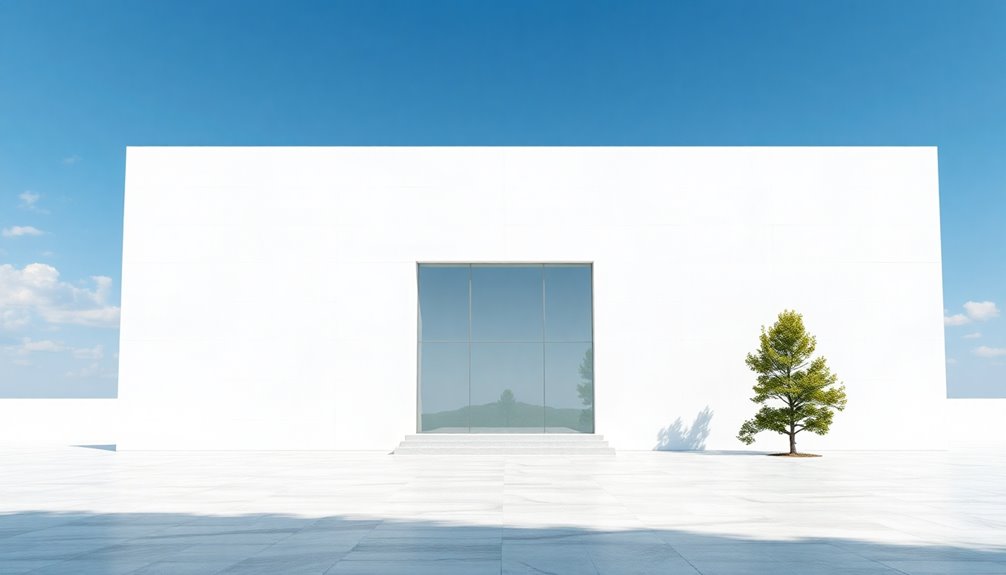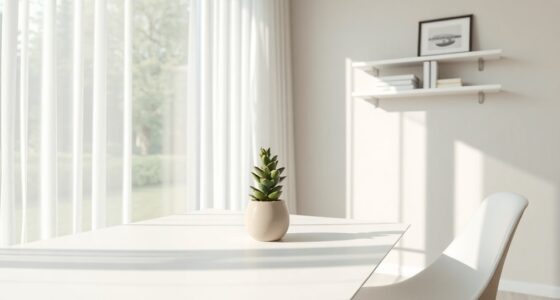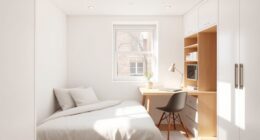Minimalist architecture strips away the unnecessary to reveal the essence of design. It emphasizes clean lines, open spaces, and a calm color palette that invites tranquility. You might wonder how these principles can reshape your living environment or influence your mindset. As we explore the characteristics and benefits of minimalist design, you'll discover its profound impact on both aesthetics and well-being. What challenges do architects face in achieving this balance?
Key Takeaways
- Minimalist architecture emphasizes simplicity through clean lines, basic geometric shapes, and a neutral color palette that promotes tranquility.
- The design focuses on functionality and open spaces, fostering a calming environment and mental clarity.
- Natural materials like wood, stone, and glass are essential, enhancing aesthetic appeal while integrating with nature.
- Effective use of natural light is crucial, as large windows and light-colored surfaces amplify openness and reduce reliance on artificial lighting.
- Iconic figures like Ludwig Mies van der Rohe and Tadao Ando exemplify the "less is more" philosophy in their minimalist designs.
Characteristics of Minimalist Architecture
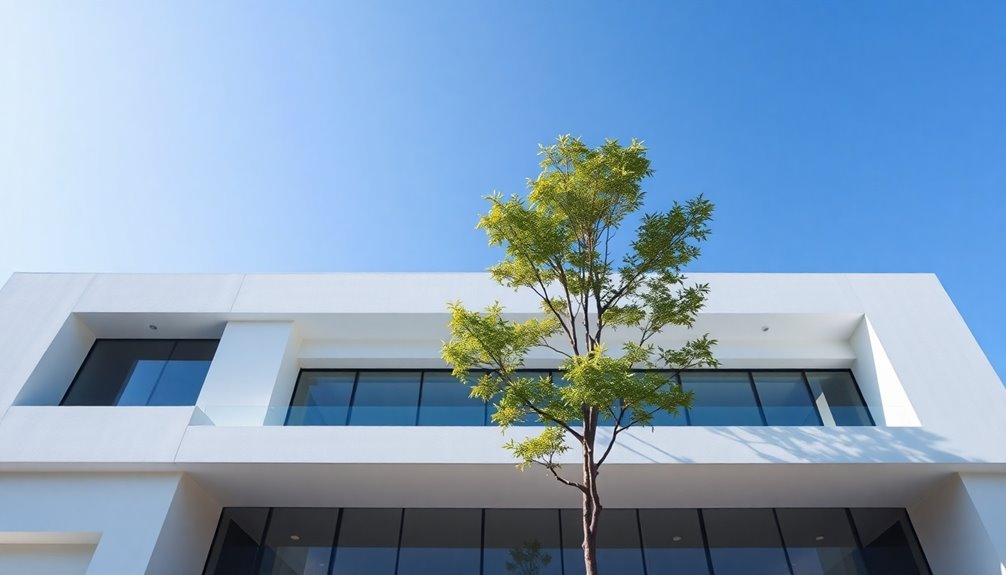
Minimalist architecture is all about embracing simplicity and functionality. In this design approach, you'll notice clean lines and basic geometric shapes that create a sense of order and tranquility.
The use of a neutral color palette, primarily featuring whites, grays, and blacks, enhances the overall aesthetic while allowing natural light to flood the space. Open spaces are a hallmark of minimalist architecture, promoting mental clarity and a serene environment.
Each element serves a specific purpose, ensuring that functionality takes precedence over unnecessary ornamentation. By focusing on essential elements, minimalist design fosters a harmonious connection between the built environment and nature, often incorporating natural materials like wood, stone, glass, and metal for added warmth and texture. Additionally, the emphasis on indoor plants can further enhance the tranquility of minimalist spaces by bringing a touch of nature indoors.
Benefits of Minimalist Design
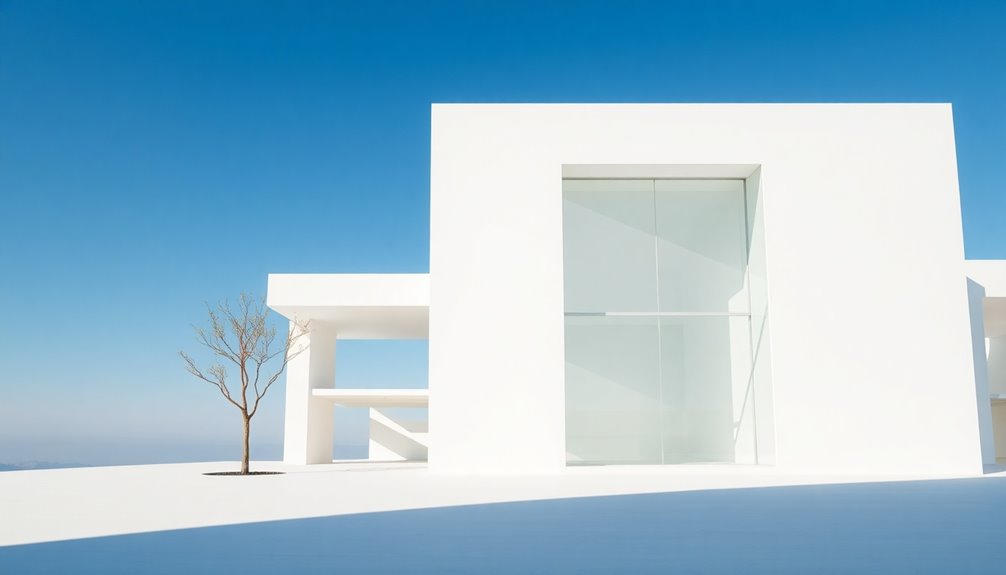
Embracing minimalist design offers numerous benefits that can transform your living or working space.
You'll find enhanced functionality, as every design element serves a clear purpose, leading to efficient use of space and resources.
The calming environment created by natural materials and a limited color palette fosters a cohesive aesthetic that promotes peace.
Open layouts and decluttered spaces encourage mindful living, reducing stress and mental clutter.
Open layouts and uncluttered spaces inspire mindfulness, alleviating stress and promoting mental clarity.
Additionally, minimalist design often integrates sustainable practices, focusing on resource efficiency and durable materials, which lowers your environmental impact.
The simplicity of these serene environments contributes to improved psychological wellness, providing a refuge from the chaos of modern life. Furthermore, embracing continuous learning in minimalist design can inspire individuals to appreciate the value of simplicity and intentionality in their daily lives.
Ultimately, minimalist design can create a balanced and harmonious atmosphere in your surroundings.
Challenges Faced in Minimalist Architecture
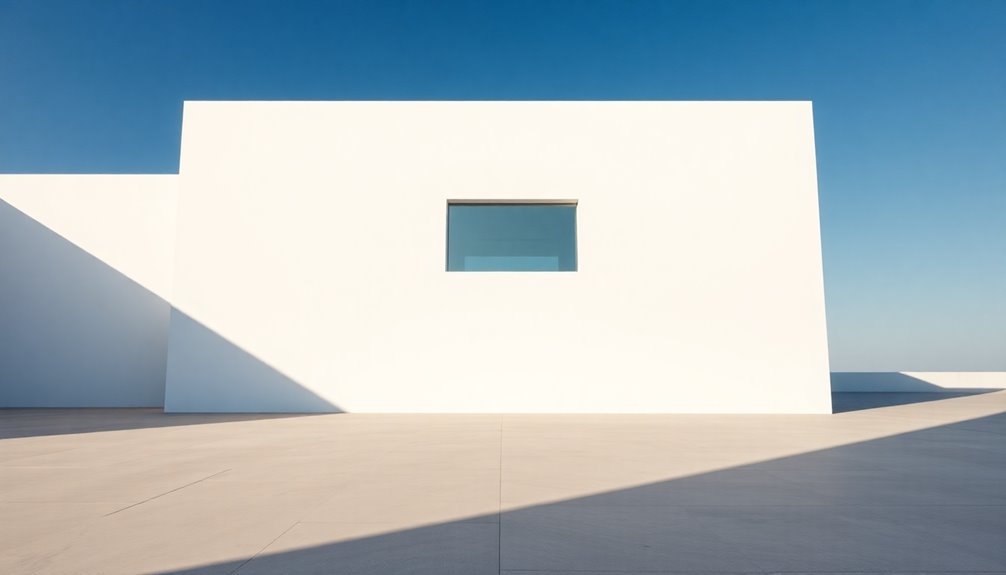
In minimalist architecture, you'll find that design precision is key, as every detail counts towards the overall aesthetic.
Balancing warmth with simplicity can be tough, too, since a stark environment might feel too cold or impersonal.
These challenges can make it tricky to create a space that feels both functional and inviting. Additionally, incorporating heat pumps can enhance indoor air quality while maintaining the minimalist ethos.
Design Precision Requirements
Precision in design is the cornerstone of minimalist architecture, where even the tiniest flaw can compromise the overall harmony of a space. To embody the "less is more" philosophy, you need to focus on clean lines and simplicity. Each choice, from materials to proportions, demands your attention to detail.
| Key Elements | Importance |
|---|---|
| Design Precision | Guarantees visual clarity |
| Clutter-Free Spaces | Enhances spatial dynamics |
| Attention to Detail | Upholds minimalist ideals |
Achieving a clutter-free appearance requires diligence, as maintaining simplicity can be challenging in complex environments. Remember, every element contributes to the overall balance and warmth essential in minimalist architecture. Additionally, incorporating natural materials can enhance the aesthetic while ensuring sustainability.
Balancing Warmth and Simplicity
Creating a minimalist space requires more than just eliminating clutter; it also means addressing the inherent challenge of warmth. In minimalist architecture, balancing warmth and simplicity is vital.
You'll want to thoughtfully integrate textures and materials to avoid a sterile atmosphere. While clean lines and a clutter-free appearance define this design philosophy, they can sometimes create an impersonal environment. Limited customization options may hinder your ability to add personal touches that reflect your character.
To maintain emotional warmth, consider incorporating meaningful decor or unique furniture pieces that resonate with you. Ongoing maintenance is essential to uphold that pristine look, but remember, it's possible to harmonize simplicity with warmth, creating a welcoming oasis without sacrificing your minimalist ideals. Additionally, incorporating natural materials can enhance the overall aesthetic and invite a sense of comfort into your space.
Pioneers of Minimalist Architecture
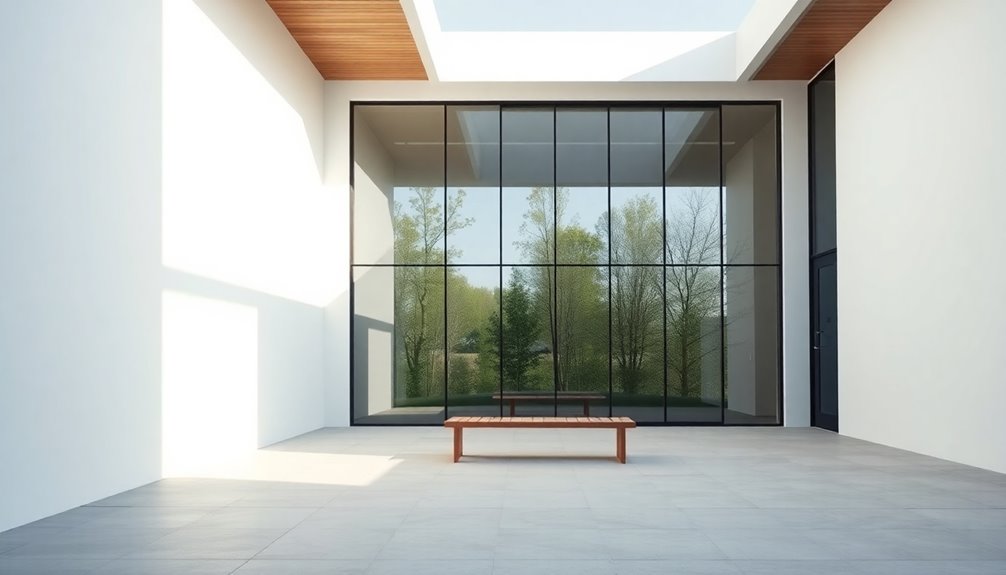
Minimalist architecture flourished thanks to the vision of several key pioneers who redefined design principles.
Ludwig Mies van der Rohe famously championed "less is more," exemplified in his Barcelona Pavilion and Farnsworth House, both featuring clean lines and open spaces.
Le Corbusier, another influential figure, embraced simplicity with designs like Villa Savoye, highlighting functionality and geometric forms.
Philip Johnson furthered the movement with his Glass House, blending indoor and outdoor spaces through natural materials.
The Bauhaus School, founded by Walter Gropius, greatly shaped minimalist architecture by promoting the unity of art, craft, and technology.
Today, contemporary architects like Tadao Ando continue this legacy, focusing on natural materials, light, and seamless integration of spaces to create serene environments. These designs often reflect the principles of spiritual guidance, emphasizing harmony and balance in the spaces we inhabit.
The Role of Natural Light in Minimalist Spaces
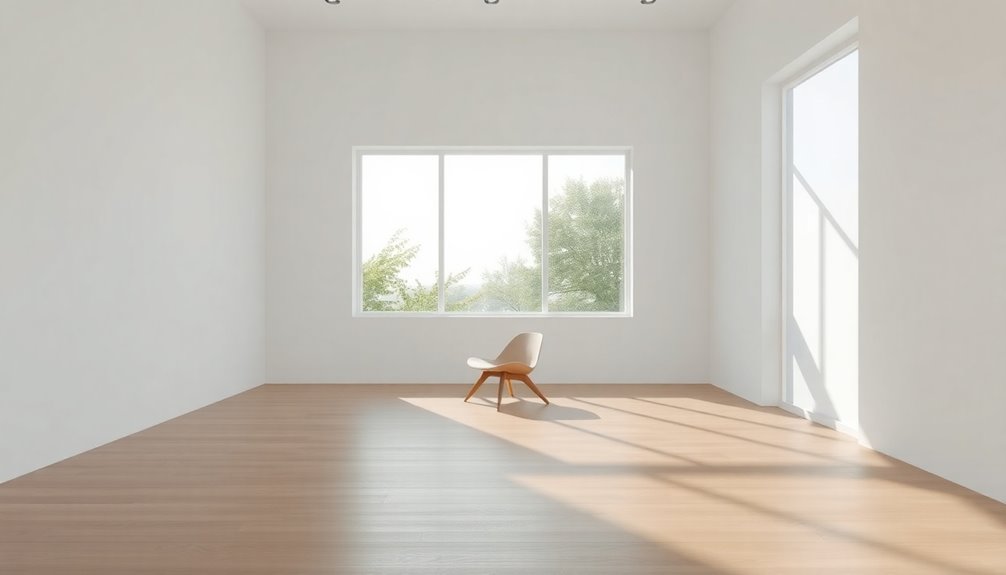
Natural light plays an essential role in shaping the essence of minimalist spaces, as it enhances the feeling of openness and fosters a connection to the outdoors.
By incorporating large windows and clean lines, you invite natural light to flood open spaces, reducing reliance on artificial lighting and boosting energy efficiency.
The interplay of light and shadow in minimalist designs creates visual interest, making your environment feel dynamic while maintaining a sense of calm.
Light-colored surfaces reflect this natural light, amplifying its effects and contributing to a brighter atmosphere.
Prioritizing natural light in architectural projects allows you to appreciate the changing qualities of light throughout the day, fostering mindfulness and enhancing your overall well-being. Additionally, the use of natural elements in decor can further promote a tranquil and serene environment.
Iconic Examples of Minimalist Architecture
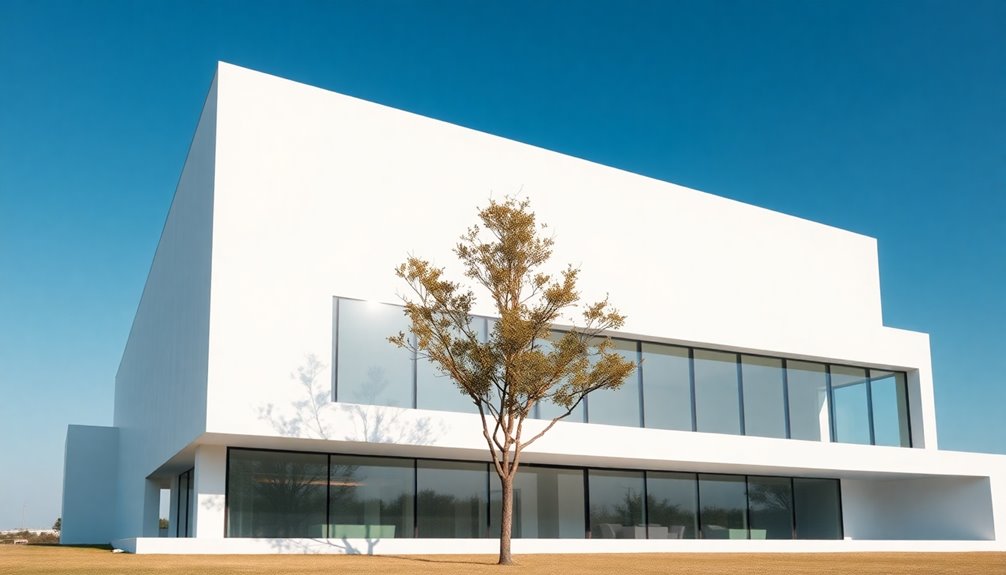
The interplay of light in minimalist spaces sets the stage for some of the most iconic architectural works.
The Barcelona Pavilion, designed by Ludwig Mies van der Rohe, exemplifies this with its simple shapes and seamless blend of indoor and outdoor areas. Its use of natural light creates a sense of tranquility, enhanced by materials like glass and onyx.
The Barcelona Pavilion embodies minimalist elegance, harmonizing natural light and materials for a tranquil, seamless experience.
Similarly, the Farnsworth House showcases transparency, elevating a glass-enclosed structure on steel columns to blur boundaries between interior and nature.
Other notable examples include Tadao Ando's Church of the Light and the Glass Pavilion by Steve Hermann, both emphasizing clean lines and modern architecture.
Each of these designs highlights the beauty of simplicity in minimalist architecture, much like how color accuracy significantly impacts overall image quality in home cinema projectors.
Frequently Asked Questions
What Is Simplicity in Architecture?
Simplicity in architecture means stripping away the unnecessary and focusing on the essential elements of design.
You'll notice clean lines and geometric forms that create an open, inviting atmosphere.
By using a limited color palette and natural materials, you enhance the space's tranquility.
This approach prioritizes functionality, ensuring every design choice serves a purpose.
Ultimately, you'll find that simplicity fosters a sense of clarity and well-being, making the environment more enjoyable to inhabit.
What Are the Characteristics of Minimalist Architecture?
Did you know that 70% of people feel less stressed in minimalist spaces?
In minimalist architecture, you'll notice clean lines and geometric forms that strip designs down to essential elements. A limited color palette, primarily in neutral tones, promotes tranquility.
You'll find natural materials like wood and stone that add warmth. Open spaces and functional layouts create a spacious feel, while strategic use of light enhances the overall aesthetic and atmosphere.
What Is the Characteristic of Minimalist Design?
Minimalist design focuses on simplicity and functionality.
You'll notice clean lines, basic geometric forms, and a limited color palette, often with neutral tones. The aim is to strip away unnecessary elements, ensuring each piece serves a purpose.
Natural materials like wood and stone add warmth while maintaining a sleek look.
You'll also see how light and shadow create visual interest, enhancing the overall aesthetic without overwhelming the space.
What Is the Principle of Minimalist Design?
The principle of minimalist design is all about stripping away the unnecessary to focus on what truly matters.
You prioritize simplicity, using clean lines and geometric forms to create a sense of clarity. Functionality drives your choices, ensuring every element serves a purpose.
You embrace the "less is more" philosophy, allowing essential elements to shine.
Conclusion
In embracing minimalist architecture, you invite simplicity and tranquility into your life. Imagine living in a sleek, open space with large windows that flood the room with natural light, like a modern home inspired by Tadao Ando's designs. This harmony not only elevates your surroundings but also promotes a clearer mind and a more focused lifestyle. By choosing minimalism, you're not just creating a home; you're cultivating a peaceful sanctuary that nurtures your well-being.
